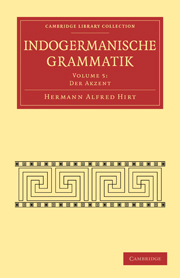Book contents
- Frontmatter
- Vorwort
- Contents
- Einleitung
- I Kapitel. Allgemeines vom Akzent
- II Kapitel. Geschichtliches
- III Kapitel. Mittel zur Erschlieβung des indogermauischen Akzents
- Erster Teil. Der Akzent der Einzelsprachen
- Zweiter Teil. Der Akzent des Indogermanischen
- Autorenverzeichnis
- Sachregister
- Wörterverzeichnis
II - Kapitel. Geschichtliches
Published online by Cambridge University Press: 05 August 2011
- Frontmatter
- Vorwort
- Contents
- Einleitung
- I Kapitel. Allgemeines vom Akzent
- II Kapitel. Geschichtliches
- III Kapitel. Mittel zur Erschlieβung des indogermauischen Akzents
- Erster Teil. Der Akzent der Einzelsprachen
- Zweiter Teil. Der Akzent des Indogermanischen
- Autorenverzeichnis
- Sachregister
- Wörterverzeichnis
Summary
Die älteste Zeit. Die Beschäftigung mit dem Akzent, genauer gesagt dem Hauptton, der indogermanischen Sprachen stammt aus verhältnismäßig später Zeit. Im Jahre 1843/44 veröffentlichte Otto Böhtlingk seine Abhandlung: Ein erster Versuch über den Akzent im Sanskrit, Mémoires der Petersburger Akademie, 6 te Serie, 7, 1 ff. Die Abhandlung erregte Aufsehen und kein anderer als Benfey schrieb darüber im Mai 1845 in der (Halleschen) Allgemeinen Literaturzeitung eine inhaltreiche, auf die hohe Bedeutung des Akzentes (Haupttones) hinweisende Anzeige, in der auch schon verschiedene Folgerungen aus der nunmehr möglichen Vergleichung des indischen und griechischen Haupttones gezogen wurden (jetzt wieder abgedruckt in Benfeys Kleinen Schriften 1, 64 ff.). In den Gött. Gel. Anz. 1846, S. 842 (Kl. Schr. 2, 69) hatte Benfeys Beschäftigung mit dem Ton schon ein bestimmtes Ergebnis gefunden. ≪Ref. glaubt, als Resultat seiner Untersuchungen geben zu können, daß der Akzent (Ton) ursprünglich nie auf der Stammsilbe, sondern auf der den Wurzelbegriff modifizierenden stand≫. Kurz darauf veröffentlichte L. Benloew ein ganz ähnliches Prinzip in seinem Buche De l'accentuation dans les langues indoeuropéennes tant anciennes que modernes. Paris 1847.
Der idg. Akzent bestand nach ihm in einer musikalischen Erhebung der Stimme. In jedem mehrsilbigen Worte wurde eine Silbe musikalisch höher gesprochen, und zwar war das jedesmal die, die dem Worte seine letzte, besondere, bestimmte Gestalt gab, z. B. das Augment beim Verbum, in den mit Präpositionen zusammengesetzten Formen die Präposition, die Präfixe, Suffixe usw.
- Type
- Chapter
- Information
- Indogermanische Grammatik , pp. 21 - 24Publisher: Cambridge University PressPrint publication year: 2009First published in: 1929



